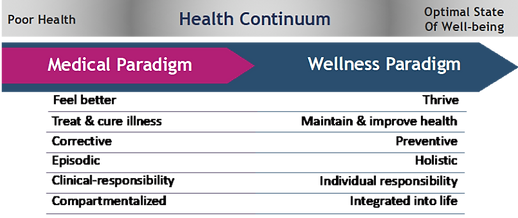WE WANT TO THANK THE GLOBAL WELLNESS INSTITUTE FOR PROVIDING THE INFORMATION ON WELLNESS IN THIS SECTION. THE GLOBAL WELLNESS INSTITUTE IS A LEADER IN PROMOTING THE WELLNESS LIFESTYLE AND WORKS TO EDUCATE, REVIEW AND REPORT ON RESEARCH INTO WELLNESS AND PROVIDE INDIVIDUALS WITH THE POWER TO BECOME WELL. FOR MORE INFORMATION ABOUT THE GLOBAL WELLNESS INSTITUE SIMPLY CLICK ON THEIR LOGO ANYWHERE YOU SEE IT ON THIS SITE. NOW LETS GET WELL!
WHAT IS WELLNESS?
Wellness is a modern word with ancient roots. The key tenets of wellness as both preventive and holistic can be traced back to ancient civilizations from the East (India, China) to the West (Greece, Rome). In 19th-century Europe and the United States, a variety of intellectual, religious and medical movements developed in parallel with conventional medicine. With their focus on holistic and natural approaches, self-healing and preventive care, these movements have provided a firm foundation for wellness today. Wellness-focused and holistic modalities have gained more visibility since the 1960s/1970s under the writings and thought leadership of an informal network of US physicians and thinkers (such as Halbert Dunn, Jack Travis, Don Ardell, Bill Hettler, and others). As these have evolved, proliferated, and gone mainstream, they have informed the healthy-living, self-help, self-care, fitness, nutrition, diet, and spiritual practices that have become a flourishing wellness movement in the 21st century.
Defining Wellness
The Global Wellness Institute defines wellness as
the active pursuit of activities, choices and lifestyles that lead to a state of holistic health.
There are two important aspects to this definition. First, wellness is not a passive or static state but rather an “active pursuit” that is associated with intentions, choices and actions as we work toward an optimal state of health and wellbeing. Second, wellness is linked to holistic health—that is, it extends beyond physical health and incorporates many different dimensions that should work in harmony.
Wellness is an individual pursuit—we have self-responsibility for our own choices, behaviors and lifestyles—but it is also significantly influenced by the physical, social and cultural environments in which we live.
Wellness is often confused with terms such as health, wellbeing and happiness. While there are common elements among them, wellness is distinguished by not referring to a static state of being (i.e., being happy, in good health, or a state of wellbeing). Rather, wellness is associated with an active process of being aware and making choices that lead toward an outcome of optimal holistic health and wellbeing.
Wellness Is Multidimensional

The Wellness Continuum
One way to understand wellness is to consider health as a continuum that extends from illness to a state of optimal wellbeing.* On one end, patients with poor health engage the medical paradigm to treat illnesses; they interact reactively and episodically with doctors and clinicians who provide care. On the opposite end, people focus proactively on prevention and maximizing their vitality. They adopt attitudes and lifestyles that prevent disease, improve health, and enhance their quality of life and sense of wellbeing. In other words, wellness is proactive, preventive and driven by self-responsibility. The growth of wellness is the extension of this consumer value and worldview.
.png)
The continuum concept is adapted from Dr. Jack Travis’ Illness-Wellness Continuum. Travis is one of the pioneers of the modern wellness movement in the late 1970s.



.jpg)
.jpg)